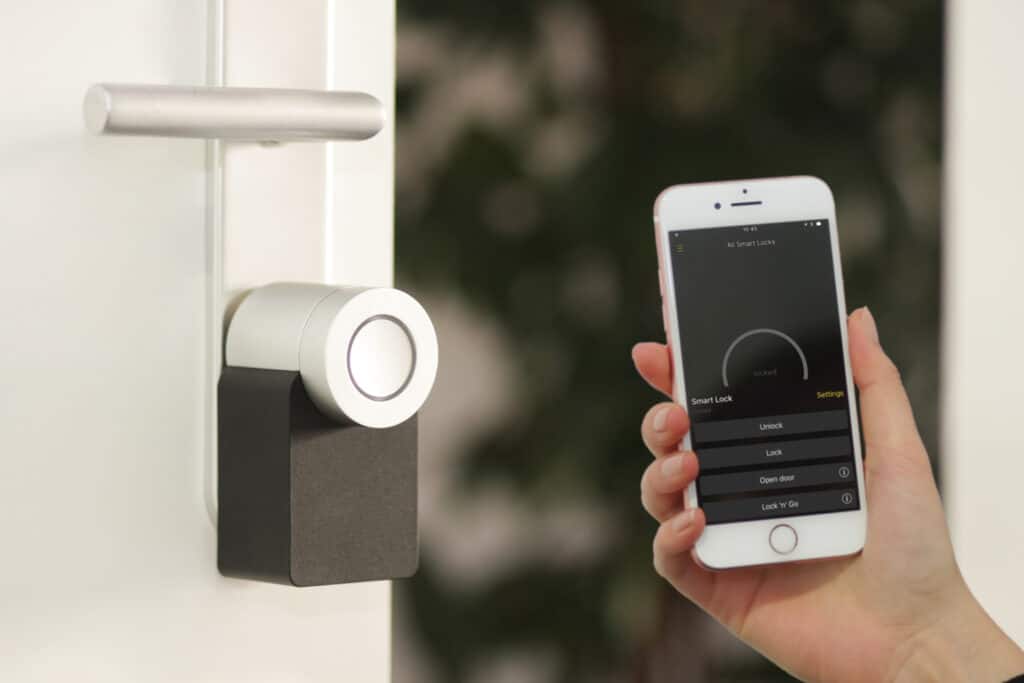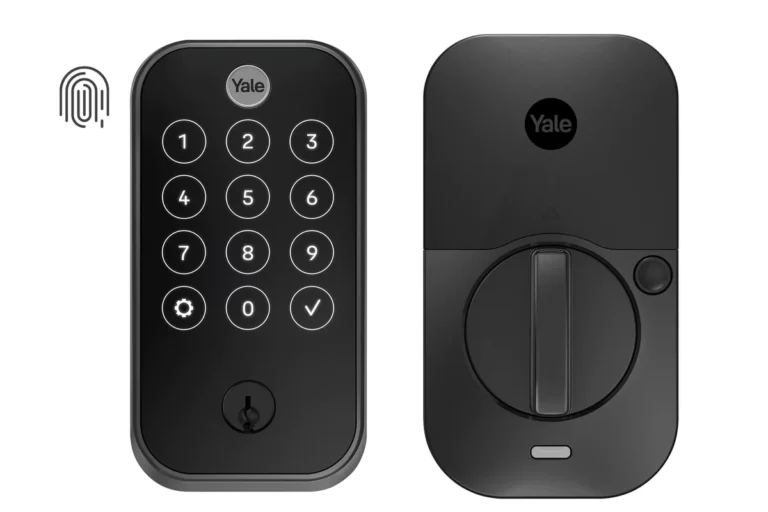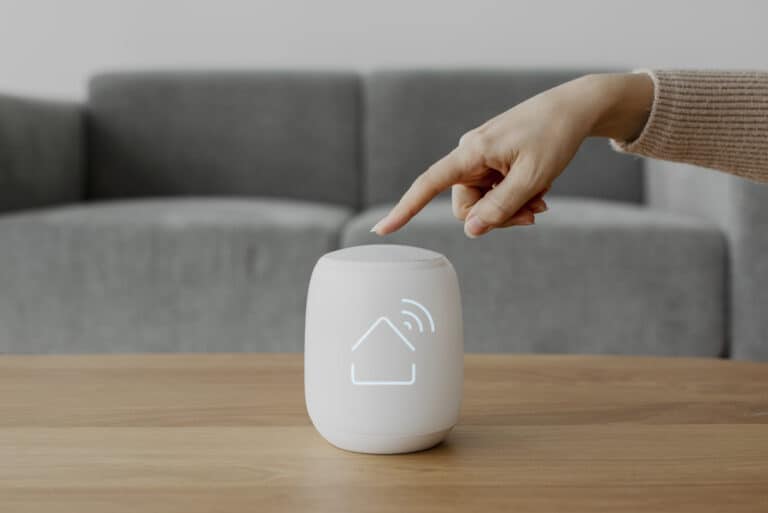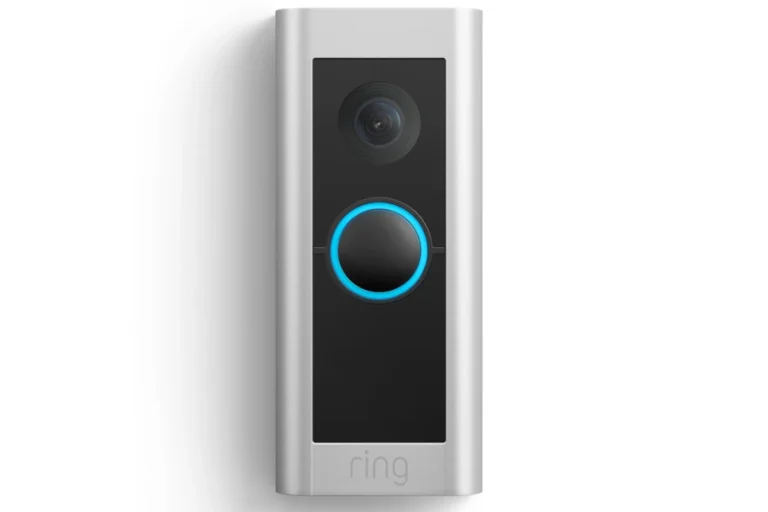Smart locks represent a significant advancement in the domain of home security and convenience. They have revolutionized the way people secure their homes by integrating technology that allows doors to be locked or unlocked via electronic means. Unlike traditional locks, smart locks can communicate with other devices in a smart home ecosystem, permitting homeowners to operate their locks remotely using smartphones or other connected devices. This capability not only enhances the convenience of not needing physical keys but also improves security by allowing users to monitor and control access to their home in real-time.
How Smart Locks Work?
| Component | Description |
|---|---|
| Lock Mechanism | Replaces or works alongside your existing deadbolt mechanism. |
| Electronic Components | Enables communication with your smartphone or other devices. |
| Wireless Connectivity | Uses technologies like Bluetooth, Wi-Fi, or Z-Wave to connect to your smartphone or home hub. |
| Mobile App | Allows you to control the lock remotely, view lock history, and manage access codes. |
Here’s a breakdown of the working process:
- Smartphone App: You interact with the lock through a dedicated app on your smartphone.
- Communication: The app sends an encrypted signal via Bluetooth, Wi-Fi, or Z-Wave to the lock.
- Unlocking: The lock receives the signal and verifies its authenticity using encryption. If valid, it triggers the unlocking mechanism (electronic or motorized).
- Locking: You can lock the door remotely through the app, or some locks automatically lock after a set time.
- Access Codes: You can create and manage unique access codes for friends, family, or service people. These codes can be temporary or permanent.
- Notifications: Some smart locks can send notifications to your phone when the lock is unlocked or tampered with.
Additional Features:
- Voice Assistants: Some locks can integrate with voice assistants like Alexa or Google Assistant for voice-controlled locking and unlocking.
- Fingerprint Recognition: Certain models offer fingerprint scanners for touchless unlocking.
- Home Automation Integration: Smart locks can be integrated with smart home systems for a more unified experience.
A typical smart lock employs different communication protocols such as Wi-Fi, Bluetooth, or Z-Wave to connect to a smart home network. Once integrated, users can control the lock through a dedicated app, which provides various capabilities like remote locking and unlocking, access logs, and the ability to grant temporary access codes to visitors. Additionally, many smart locks come with added features such as voice control through digital assistants, automatic locking schedules, and alerts for security breaches. These functionalities combine to offer users a compelling mix of convenience, monitoring, and enhanced control over home security.

Key Takeaways
- Smart locks enhance home security by allowing remote operation and real-time access monitoring.
- They connect to home networks using various protocols, enabling control via apps and integration with other smart devices.
- Additional features of smart locks may include access schedules, voice commands, and security alerts.
Understanding Smart Lock Technology
Smart locks bring a new level of convenience and security to home access. By replacing traditional keys with digital alternatives, they provide users with the flexibility to control locks using various devices and methods.
Components and Mechanisms
A smart lock consists of several key components that work together to secure a door. These include:
- Motorized Deadbolt: This part physically engages and disengages the lock.
- Power Source: Usually batteries that activate the deadbolt.
- Actuator: Connects the deadbolt to the motor.
When an authorized command is received, the actuator triggers the motor to move the deadbolt, either locking or unlocking the door.
Smart Lock Connectivity Options
Smart locks can communicate using:
- Bluetooth: Allows short-range commands from a nearby device.
- Wi-Fi: Enables remote access via internet from anywhere.
Users can typically manage their smart locks with:
- Smartphone Apps: For direct control and access logs.
- Keypads: To enter a selectable password.
- Fingerprint Sensors: For biometric access.
Installation and Setup
To install a smart lock:
- Remove the Existing Lock: Take out the traditional deadbolt.
- Install the Smart Lock: Carefully place the new device where the old one was.
The setup usually involves:
- Connecting to a Power Source: Insert batteries.
- Syncing with Connectivity Method: Set up with Bluetooth or Wi-Fi through the smartphone app.
- Programming Access Methods: Create and enter passwords, fingerprints, or pair devices.
Features and Security
In this section, we’ll focus on the specific features that enable smart locks to offer enhanced security and seamless operation within smart home environments.
Unlocking Capabilities and User Access
Smart locks provide keyless entry by using various methods to lock and unlock doors. They often work through a phone app, allowing users to control access remotely. Users can also grant temporary access to visitors, which is ideal for instances like vacation rental properties. These devices usually operate on batteries, avoiding reliance on home power systems. Typically, smart locks feature options like auto-locking, which automatically secures the door after it closes, and two-factor authentication, which adds an extra layer of security.
Enhancing Home Security
These locks connect to a home security system for a comprehensive approach to safety. Integration with security cameras can allow users to visually confirm who is accessing their home. Smart locks often come with built-in encryption, making it difficult for unauthorized users to hack into the system. Many are capable of sending notifications to a user’s phone, providing immediate updates on home security status and alerting homeowners if a lock is tampered with.
Integration with Smart Home Ecosystems
Smart locks can play a central role in a connected home by integrating with other smart devices. They may support voice commands through virtual assistants like Alexa or Google Assistant, making lock and unlock actions hands-free. Additionally, they often share status information with other devices, which enables actions such as turning on lights when a door is unlocked. Smart lock manufacturers prioritize peace of mind by ensuring that devices work in tandem with the rest of the smart home for an enhanced security experience.
Frequently Asked Questions
Many people have questions about smart locks and how they improve home security. This section addresses several common inquiries.
What are the security features of smart locks compared to traditional locks?
Smart locks offer advanced features like encrypted signals and the ability to track access history. Unlike traditional locks, they can alert homeowners to unauthorized attempts to unlock the door.
Can smart locks be integrated with home automation systems like Z-Wave or ADT?
Yes, many smart locks can connect with home automation systems using technology like Z-Wave or Wi-Fi. This integration allows for seamless control over home security within a comprehensive smart home setup.
What are the primary methods of unlocking a smart lock, such as keypad or mobile app?
Smart locks typically provide various access methods including keypads, mobile apps, and even fingerprint recognition. Users can select the method that best fits their needs.
How do smart locks interact with guest access systems, such as those used in Airbnb properties?
Smart locks enhance guest access by allowing property owners to assign temporary codes or digital keys. This convenience supports a more streamlined check-in process for short-term rental properties.
What are the common power sources for smart locks, and how often do they need to be replaced or recharged?
Most smart locks run on batteries. The longevity of these batteries can vary, but many models signal when the power is low. Depending on usage, replacement or recharging may be required periodically.
What are the potential vulnerabilities or disadvantages of using smart locks for home security?
Despite their convenience, smart locks can have vulnerabilities like hacking or malfunctions during power outages. Regular updates and understanding backup options can help mitigate these risks.





